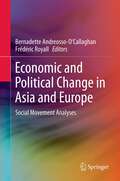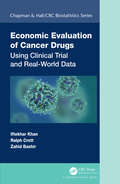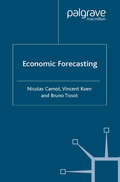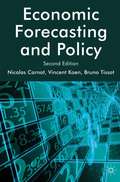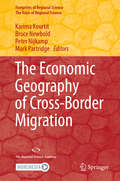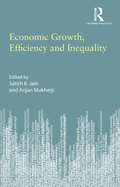- Table View
- List View
Economic and Financial Modelling with EViews
by Abdulkader Aljandali Motasam TatahiThis practical guide in Eviews is aimed at practitioners and students in business, economics, econometrics, and finance. It uses a step-by-step approach to equip readers with a toolkit that enables them to make the most of this widely used econometric analysis software. Statistical and econometrics concepts are explained visually with examples, problems, and solutions.Developed by economists, the Eviews statistical software package is used most commonly for time-series oriented econometric analysis. It allows users to quickly develop statistical relations from data and then use those relations to forecast future values of the data. The package provides convenient ways to enter or upload data series, create new series from existing ones, display and print series, carry out statistical analyses of relationships among series, and manipulate results and output. This highly hands-on resource includes more than 200 illustrative graphs and tables and tutorials throughout. Abdulkader Aljandali is Senior Lecturer at Coventry University in London. He is currently leading the Stochastic Finance Module taught as part of the Global Financial Trading MSc. His previously published work includes Exchange Rate Volatility in Emerging Markers, Quantitative Analysis, Multivariate Methods & Forecasting with IBM SPSS Statistics and Multivariate Methods and Forecasting with IBM® SPSS® Statistics. Dr Aljandali is an established member of the British Accounting and Finance Association and the Higher Education Academy.Motasam Tatahi is a specialist in the areas of Macroeconomics, Financial Economics, and Financial Econometrics at the European Business School, Regent’s University London, where he serves as Principal Lecturer and Dissertation Coordinator for the MSc in Global Banking and Finance at The European Business School-London.
Economic and Management Perspectives on Intellectual Property Rights (Applied Econometrics Association Series)
by C. Peeters B. Van Pottelsberghe De La Potterie Bruno Van Pottelsberghe De La PotterieThis book provides a better understanding of how intellectual property can improve economic and business performance. It focuses on three particular issues: the valuation of patents, the transfer of knowledge, and the management of innovation and intellectual property. Scholars from leading worldwide institutions use quantitative methods and advanced survey techniques to explore the complex relationship between patents, innovation, venture capital and scientific research. The book focuses on three broad issues: the valuation of patents, the transfer of knowledge, and the management of innovation and intellectual property.
Economic and Political Change in Asia and Europe: Social Movement Analyses
by Bernadette Andreosso-O'Callaghan and Frédéric RoyallSince the 1973 publication of Alain Peyrefitte’s prophetic When China Awakens, developments in East Asia have outstripped even the wildest predictions. China has undergone the fastest industrialization and urbanization process in history, yet tensions there are rising as some realize how far they have been left behind. This volume explores the applicability of European economic and social models to our analysis of East Asia’s and, in particular, China’s situation. Though millions of Chinese and other Asian people have been lifted out of poverty, inequality is rising nonetheless, and contemporary Europe and Asia are both witnessing collective action against rampant economic neoliberalism in the former and the exclusion of minorities in the latter. It is difficult to overstate the relevance of this assessment, which seeks answers to some central questions: Can events in Europe serve as a model for those in East Asia? Are there similarities or differences between the two regions? To what extent do political, economic or social systems stimulate or inhibit collective action? How culturally equivalent are the collective actions of marginalized/ disadvantaged people in the two locations, or are events in Europe symptomatic of specific cultural attributes? Comparing and contrasting the research tools and dominant paradigms in the social and economic sciences in East Asia and Europe, as this volume does, throws out some revealing results.
Economic Applications of Quantile Regression (Studies in Empirical Economics)
by Bernd Fitzenberger Roger Koenker Jose A. F. MachadoQuantile regression has emerged as an essential statistical tool of contemporary empirical economics and biostatistics. Complementing classical least squares regression methods which are designed to estimate conditional mean models, quantile regression provides an ensemble of techniques for estimating families of conditional quantile models, thus offering a more complete view of the stochastic relationship among variables. This volume collects 12 outstanding empirical contributions in economics and offers an indispensable introduction to interpretation, implementation, and inference aspects of quantile regression.
Economic Cycles in Emerging and Advanced Countries: Synchronization, International Spillovers and the Decoupling Hypothesis (Contributions to Economics)
by Antonio PesceThis book contributes to the debate on the decoupling of emerging economies from the advanced economies with a new, empirical investigation approach. Taking counterfactual experiments performed using a time-varying panel VAR model, the author argues that over the last thirty years, emerging economies have become less vulnerable to shocks spreading from advanced economies. This resilience to external shocks has changed in a non-progressive manner over time, with phases of greater resilience followed by others of lower resilience and vice versa. This research outlines its wave-like path and presents new results that contribute to the discussion.
Economic Dynamics and General Equilibrium: Time and Uncertainty
by Anders BorglinThe developments of economic theory in the 1950s served to pinpoint important underlying assumptions in the study of market institutions. The conflict between observed institutions and the benchmark interpretation became apparent. This led to the introduction of new equilibrium concepts. The emphasis was on the possibilities to transfer purchasing power over time using spot markets involving assets or money. This advanced textbook focuses on the developments in the theory of incomplete markets and overlapping generations economies where income transfers over time are restricted either by available assets or by the unfeasibility of contracts with unborn generations. It bridges the gap between standard textbooks on microeconomics and more advanced expositions. Contains diagrams, examples and exercises.
Economic Dynamics and Information (Lecture Notes in Economics and Mathematical Systems #576)
by Jaroslav ZajacThis book analyzes the existence of equilibria in economies having a measured space of agents and a continuum of agents and commodities. Excessive homogeneity with respect to agent productivity leads to instability and non-uniqueness of a given stationary state and the indeterminacy of the corresponding stationary state equilibrium. Sufficient heterogeneity leads to global saddle-path stability, uniqueness of a given stationary state and the global uniqueness of the corresponding equilibrium.
Economic Evaluation of Cancer Drugs: Using Clinical Trial and Real-World Data (Chapman & Hall/CRC Biostatistics Series)
by Iftekhar Khan Ralph Crott Zahid BashirCancer is a major healthcare burden across the world and impacts not only the people diagnosed with various cancers but also their families, carers, and healthcare systems. With advances in the diagnosis and treatment, more people are diagnosed early and receive treatments for a disease where few treatments options were previously available. As a result, the survival of patients with cancer has steadily improved and, in most cases, patients who are not cured may receive multiple lines of treatment, often with financial consequences for the patients, insurers and healthcare systems. Although many books exist that address economic evaluation, Economic Evaluation of Cancer Drugs using Clinical Trial and Real World Data is the first unified text that specifically addresses the economic evaluation of cancer drugs. The authors discuss how to perform cost-effectiveness analyses while emphasising the strategic importance of designing cost-effectiveness into cancer trials and building robust economic evaluation models that have a higher chance of reimbursement if truly cost-effective. They cover the use of real-world data using cancer registries and discuss how such data can support or complement clinical trials with limited follow up. Lessons learned from failed reimbursement attempts, factors predictive of successful reimbursement and the different payer requirements across major countries including US, Australia, Canada, UK, Germany, France and Italy are also discussed. The book includes many detailed practical examples, case studies and thought-provoking exercises for use in classroom and seminar discussions. Iftekhar Khan is a medical statistician and health economist and a lead statistician at Oxford Unviersity’s Center for Statistics in Medicine. Professor Khan is also a Senior Research Fellow in Health Economics at University of Warwick and is a Senior Statistical Assessor within the Licensing Division of the UK Medicine and Health Regulation Agency. Ralph Crott is a former professor in Pharmacoeconomics at the University of Montreal in Quebec, Canada and former head of the EORTC Health Economics Unit and former senior health economist at the Belgian HTA organization. Zahid Bashir has over twelve years experience working in the pharmaceutical industry in medical affairs and oncology drug development where he is involved in the design and execution of oncology clinical trials and development of reimbursement dossiers for HTA submission.
Economic Evaluation of Cancer Drugs: Using Clinical Trial and Real-World Data (Chapman & Hall/CRC Biostatistics Series)
by Iftekhar Khan Ralph Crott Zahid BashirCancer is a major healthcare burden across the world and impacts not only the people diagnosed with various cancers but also their families, carers, and healthcare systems. With advances in the diagnosis and treatment, more people are diagnosed early and receive treatments for a disease where few treatments options were previously available. As a result, the survival of patients with cancer has steadily improved and, in most cases, patients who are not cured may receive multiple lines of treatment, often with financial consequences for the patients, insurers and healthcare systems. Although many books exist that address economic evaluation, Economic Evaluation of Cancer Drugs using Clinical Trial and Real World Data is the first unified text that specifically addresses the economic evaluation of cancer drugs. The authors discuss how to perform cost-effectiveness analyses while emphasising the strategic importance of designing cost-effectiveness into cancer trials and building robust economic evaluation models that have a higher chance of reimbursement if truly cost-effective. They cover the use of real-world data using cancer registries and discuss how such data can support or complement clinical trials with limited follow up. Lessons learned from failed reimbursement attempts, factors predictive of successful reimbursement and the different payer requirements across major countries including US, Australia, Canada, UK, Germany, France and Italy are also discussed. The book includes many detailed practical examples, case studies and thought-provoking exercises for use in classroom and seminar discussions. Iftekhar Khan is a medical statistician and health economist and a lead statistician at Oxford Unviersity’s Center for Statistics in Medicine. Professor Khan is also a Senior Research Fellow in Health Economics at University of Warwick and is a Senior Statistical Assessor within the Licensing Division of the UK Medicine and Health Regulation Agency. Ralph Crott is a former professor in Pharmacoeconomics at the University of Montreal in Quebec, Canada and former head of the EORTC Health Economics Unit and former senior health economist at the Belgian HTA organization. Zahid Bashir has over twelve years experience working in the pharmaceutical industry in medical affairs and oncology drug development where he is involved in the design and execution of oncology clinical trials and development of reimbursement dossiers for HTA submission.
Economic Evolution and Equilibrium: Bridging the Gap (Lecture Notes in Economics and Mathematical Systems #591)
by Marco Lehmann-WaffenschmidtThis work uses various model frameworks to study the evolution of equilibria in an open loop evolving economy in which the model characteristics evolve without any directional restrictions except for continuity. Applying mathematical methods, it is shown that equilibria can always be adapted in a piecewise gradual, non bang-bang way.
Economic Evolution, Learning, and Complexity
by Uwe Cantner Horst Hanusch Steven KlepperThe twelve papers in this collection grew out of the workshop on "Eco nomic Evolution, Learning, and Complexity" held at the University of Augsburg, Augsburg, Germany on May 23-25, 1997. The Augsburg workshop was the second of two events in the Euroconference Series on Evolutionary Economics, the first of which was held in Athens, Greece in September 1993. A special issue of the Journal of Evolutionary Econo mics (1993(4)) edited by Yannis Katsoulacos on "Evolutionary and Neo classical Perspectives on Market Structure and Economic Growth" con tains selected papers from the Athens conference. The Athens conference explored neoclassical and evolutionary perspectives on technological competition and increasing returns. It helped to identify the dis tinguishing features of evolutionary scholarship. The Augsburg workshop was more oriented toward exploring methodological issues in evolutiona of the papers employed new me ry and related scholarship. A number thods, such as genetic programming and experimental analysis, some developed new econometric techniques or raised new empirical issues in evolutionary economics, and some relied on simulation techniques. Twelve papers covering a range of areas were selected for this collection. The papers address central issues in evolutionary and Schumpeterian accounts of industrial competition, learning, and innovation.
Economic Fables
by Ariel RubinsteinPart memoir, part crash-course in economic theory, this deeply engaging book by one of the world's foremost economists looks at economic ideas through a personal lens. Together with an introduction to some of the central concepts in modern economic thought, Ariel Rubinstein offers some powerful and entertaining reflections on his childhood, family and career. In doing so, he challenges many of the central tenets of game theory, and sheds light on the role economics can play in society at large. The book is as thought-provoking for seasoned economists as it is enlightening for newcomers to the field. Sylvia Nasar, author of A Beautiful Mind, describes Economics Fables as a "wonderfully inviting introduction to game theory, rich in personalities, history and sense of place. Ariel Rubinstein is not only a brilliant theorist with a knack for lucid exposition, but a gifted storyteller. Students will find the ideas surprisingly accessible. Aspiring scholars, wondering whether a life of the mind is worth pursuing, will find his personal journey of intellectual discovery thrilling."
Economic Forecasting
by N. Carnot V. Koen B. TissotEconomic Forecasting provides a comprehensive overview of macroeconomic forecasting. The focus is first on a wide range of theories as well as empirical methods: business cycle analysis, time series methods, macroeconomic models, medium and long-run projections, fiscal and financial forecasts, and sectoral forecasting. In addition, the book addresses the main issues surrounding the use of forecasts (accuracy, communication challenges) and their policy implications. A tour of the economic data and forecasting institutions is also provided.
Economic Forecasting
by Graham Elliott Allan TimmermannEconomic forecasting involves choosing simple yet robust models to best approximate highly complex and evolving data-generating processes. This poses unique challenges for researchers in a host of practical forecasting situations, from forecasting budget deficits and assessing financial risk to predicting inflation and stock market returns. Economic Forecasting presents a comprehensive, unified approach to assessing the costs and benefits of different methods currently available to forecasters.This text approaches forecasting problems from the perspective of decision theory and estimation, and demonstrates the profound implications of this approach for how we understand variable selection, estimation, and combination methods for forecasting models, and how we evaluate the resulting forecasts. Both Bayesian and non-Bayesian methods are covered in depth, as are a range of cutting-edge techniques for producing point, interval, and density forecasts. The book features detailed presentations and empirical examples of a range of forecasting methods and shows how to generate forecasts in the presence of large-dimensional sets of predictor variables. The authors pay special attention to how estimation error, model uncertainty, and model instability affect forecasting performance.Presents a comprehensive and integrated approach to assessing the strengths and weaknesses of different forecasting methodsApproaches forecasting from a decision theoretic and estimation perspectiveCovers Bayesian modeling, including methods for generating density forecastsDiscusses model selection methods as well as forecast combinationsCovers a large range of nonlinear prediction models, including regime switching models, threshold autoregressions, and models with time-varying volatilityFeatures numerous empirical examplesExamines the latest advances in forecast evaluationEssential for practitioners and students alike
Economic Forecasting and Policy
by N. Carnot V. Koen B. TissotEconomic Forecasting provides a comprehensive overview of macroeconomic forecasting. The focus is first on a wide range of theories as well as empirical methods: business cycle analysis, time series methods, macroeconomic models, medium and long-run projections, fiscal and financial forecasts, and sectoral forecasting.
Economic Foundation of Asset Price Processes (ZEW Economic Studies #24)
by Erik Paul LüdersIn this book the relation between the characteristics of investors' preferences and expectations and equilibrium asset price processes are analysed. It is shown that declining elasticity of the pricing kernel can lead to positive serial correlation of short term asset returns and negative serial correlation of long term returns. Analytical asset price processes are also derived. In contrast to the widely used "empirical" time-series models these processes do not lack a sound economic foundation. Moreover, in contrast to the popular Ornstein Uhlenbeck process and the Constant Elasticity of Variance model the proposed stochastic processes are consistent with a classical representative investor economy.
Economic Foundations for Finance: From Main Street to Wall Street (Springer Texts in Business and Economics)
by Thorsten Hens Sabine ElmigerThis book provides readers with essential concepts from financial economics for an integrated study of the financial system and the real economy. It discusses how long-term market prices are determined and affected by population growth, technological progress and non-renewable resources. The meaning of market prices is examined from the perspective of households and from the perspective of firms. The book therefore connects different fields of finance, which usually focus only on either the households’ side or the firms’ side.
The Economic Geography of Cross-Border Migration (Footprints of Regional Science)
by Karima Kourtit Bruce Newbold Peter Nijkamp Mark PartridgeThis handbook presents a collection of high-quality, authoritative scientific contributions on cross-border migration, written by a carefully selected group of recognized migration experts from around the globe. In recent years, cross-border migration has become an important and intriguing issue, from both a scientific and policy perspective. In the ‘age of migration’, the volume of cross-border movements of people continues to rise, while the nature of migration flows – in terms of the determinants, length of stay, effects on the sending and host countries, and legal status of migrants – is changing dramatically. Based on a detailed economic-geographical analysis, this handbook studies the motives for cross-border migration, the socio-economic implications for sending countries and regions, the locational choice determinants for cross-border migrants, and the manifold economic-geographic consequences for host countries and regions. Given the complexity of migration decisions and their local or regional impacts, a systematic typology of migrants (motives, legal status, level of education, gender, age, singles or families, etc.) is provided, together with an assessment of push factors in the place of origin and pull factors at the destination. On the basis of a solid analytical framework and reliable empirical evidence, it examines the impacts of emigration for sending areas and of immigration for receiving areas, and provides a comprehensive discussion of the policy dimensions of cross-border migration.
Economic Growth: Theory and Numerical Solution Methods (Springer Texts in Business and Economics)
by Alfonso Novales Esther Fernández Jesús RuizThis is a book on deterministic and stochastic Growth Theory and the computational methods needed to produce numerical solutions. Exogenous and endogenous growth models are thoroughly reviewed. Special attention is paid to the use of these models for fiscal and monetary policy analysis. Modern Business Cycle Theory, the New Keynesian Macroeconomics, the class of Dynamic Stochastic General Equilibrium models, can be all considered as special cases of models of economic growth, and they can be analyzed by the theoretical and numerical procedures provided in the textbook.Analytical discussions are presented in full detail. The book is self contained and it is designed so that the student advances in the theoretical and the computational issues in parallel. EXCEL and Matlab files are provided on an accompanying website (see Preface to the Second Edition) to illustrate theoretical results as well as to simulate the effects of economic policy interventions. The structure of these program files is described in "Numerical exercise"-type of sections, where the output of these programs is also interpreted. The second edition corrects a few typographical errors and improves some notation.
Economic Growth: Theory and Numerical Solution Methods (Springer Texts in Business and Economics)
by Alfonso Novales Esther Fernández Jesús RuizThis is the third corrected and extended edition of a book on deterministic and stochastic Growth Theory and the computational methods needed to produce numerical solutions. Exogenous and endogenous growth, non-monetary and monetary models are thoroughly reviewed. Special attention is paid to the use of these models for fiscal and monetary policy analysis. Models under modern theories of the Business Cycle, New Keynesian Macroeconomics, and Dynamic Stochastic General Equilibrium models, can be all considered as special cases of economic growth models, and they can be analyzed by the theoretical and numerical procedures provided in the textbook.Analytical discussions are presented in full detail. The book is self-contained and it is designed so that the student advances in the theoretical and the computational issues in parallel. Spreadsheets are used to solve simple examples. Matlab files are provided on an accompanying website to illustrate theoretical results from all chapters as well as to simulate the effects of economic policy interventions. The logical structure of these program files is described in "Numerical exercise"-type of sections, where the output of these programs is also interpreted. The third edition corrects a few typographical errors, includes two new and original chapters on frequentist and Bayesian estimation, and improves some notation.
Economic Growth: Theory and Numerical Solution Methods
by Alfonso Novales Esther Fernández Jesús RuízThis is a book on deterministic and stochastic Growth Theory and the computational methods needed to produce numerical solutions. Exogenous and endogenous growth models are thoroughly reviewed. Special attention is paid to the use of these models for fiscal and monetary policy analysis. Modern Business Cycle Theory, the New Keynesian Macroeconomics, the class of Dynamic Stochastic General Equilibrium models, can be all considered as special cases of models of economic growth, and they can be analyzed by the theoretical and numerical procedures provided in the textbook. Analytical discussions are presented in full detail. The book is self contained and it is designed so that the student advances in the theoretical and the computational issues in parallel. EXCEL and Matlab files are provided on an accompanying website to illustrate theoretical results as well as to simulate the effects of economic policy interventions.
Economic Growth and the Middle Class in an Economy in Transition: The Case of Russia (Economic Studies in Inequality, Social Exclusion and Well-Being)
by Zoya NissanovThis book studies the evolution of the middle class in Russia after the fall of the Soviet Union. Using data from the RLMS (Russian Longitudinal Monitoring Survey), the volume covers the period of transition (1991-2008) during which many fundamental economic reforms were implemented. The first part of the book is devoted to a discussion of the concept of middle class and a description of the economic situation in Russia during the transition period. Particular attention is given to variations in the distribution of Russian incomes and the estimated importance of the middle class. The second part of the book focuses on the link between the middle class and income bipolarization. The third and last section of the book uses the semiparametric "mixture model" to discover how many different groups may be derived from the income distribution in Russia, as well as what the main socio-economic and demographic characteristics of those groups are. The mobility of households into and out of the middle class during the transition period is also studied in hopes of determining the factors that contribute to such mobility. Using rigorous empirical methods, this volume sheds light on a relatively unstudied economic group and provides insight for countries which are about to enter a transition period. As such, this book will be of great interest to researchers in economics and inequality as well as professionals and practitioners working with international organizations.
Economic Growth, Efficiency and Inequality
by Satish K. Jain Anjan MukherjiThis volume deals with a range of contemporary issues in Indian and other world economies, with a focus on economic theory and policy and their longstanding implications. It analyses and predicts the mechanisms that can come into play to determine the function of institutions and the impact of public policy.
Economic Growth, Efficiency and Inequality
by Satish K. Jain Anjan MukherjiThis volume deals with a range of contemporary issues in Indian and other world economies, with a focus on economic theory and policy and their longstanding implications. It analyses and predicts the mechanisms that can come into play to determine the function of institutions and the impact of public policy.
Economic Hierarchies, Organization and the Structure of Production (Studies in Public Choice #7)
by G. TullockEconomics has been basically a study of the interactions between organizations, with some organizations being so small we only have one person in them. The internal organization of the largest hierarchies has indeed been looked at, but a good reason for working less on these organizations is that the internal reactions are much harder to understand. It is sensible to solve the problems we can solve and put the others off until later. The author's basic purpose here is to look at these larger hierarchical organizations, and develop a scientific account of them. In Economic Hierarchies, Organization and the Structure of Production Gordon Tullock examines the internal functioning and organization of the corporation. In the author's personal tradition, the book relies on narrative analysis rather than mathematical complexity to convey insights into the functioning of the corporation.


